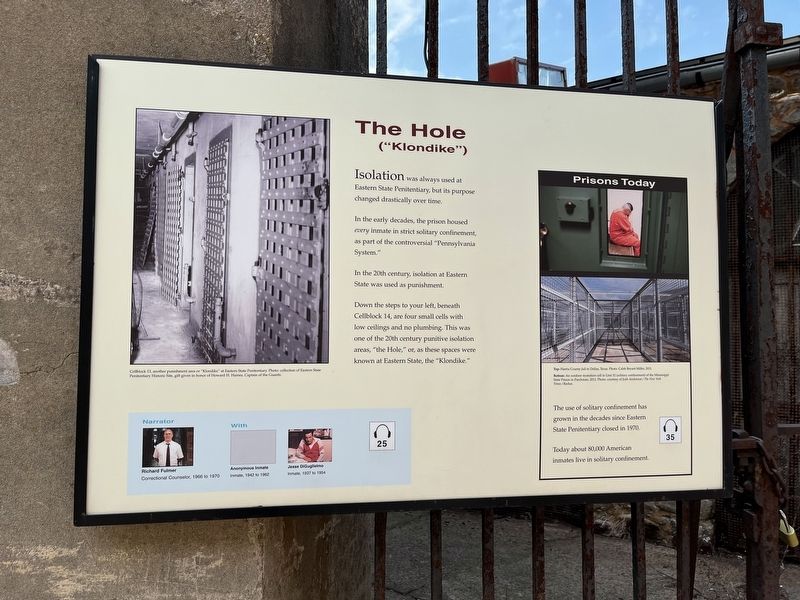Eastern State Penitentiary in Philadelphia in Philadelphia County, Pennsylvania — The American Northeast (Mid-Atlantic)
The Hole
Klondike
Isolation was always used at Eastern State Penitentiary, but its purpose changed drastically over time.
In the early decades, the prison housed every inmate in strict solitary confinement, as part of the controversial "Pennsylvania System."
In the 20th century, isolation at Eastern State was used as punishment.
Down the steps to your left, beneath Cellblock 14, are four small cells with low ceilings and no plumbing. This was one of the 20th century punitive isolation areas, "the Hole," or, as these spaces were known at Eastern State, the "Klondike."
Prisons Today
The use of solitary confinement has grown in the decades since Eastern State Penitentiary closed in 1970.
Today about 80,000 American inmates live in solitary confinement.
Erected by Eastern State Penitentiary Historic Site.
Topics. This historical marker is listed in these topic lists: Civil Rights • Law Enforcement. A significant historical year for this entry is 1970.
Location. 39° 58.139′ N, 75° 10.293′ W. Marker is in Philadelphia, Pennsylvania, in Philadelphia County. It is in Eastern State Penitentiary. Marker can be reached from Fairmount Avenue west of Corinthian Avenue, on the right when traveling west . Touch for map. Marker is at or near this postal address: 2027 Fairmount Ave, Philadelphia PA 19130, United States of America. Touch for directions.
Other nearby markers. At least 8 other markers are within walking distance of this marker. Tuberculosis Yard (here, next to this marker); Cellblock 14 (here, next to this marker); Incinerator (within shouting distance of this marker); 2020 Rate of Incarceration (within shouting distance of this marker); The Big Graph (within shouting distance of this marker); Death Row Courtyard (within shouting distance of this marker); Abandonment / Prisons Today (within shouting distance of this marker); Morgue (within shouting distance of this marker). Touch for a list and map of all markers in Philadelphia.
Also see . . . If The Steel Walls Could Talk: The Abuse of Human Rights Through The Use Of Solitary Confinement. Article from December 2, 2019 from the University of Alabama at Birmingham Institute for Human Rights Blog. This article notes that solitary confinement was initially used at Eastern State Penitentiary. Additionally, since 1990, the United Nations has decried solitary confinement as a form of torture.
"...[T]he first documented use of solitary confinement in 1829. It was used in the Eastern State Penitentiary in Philadelphia. Based in Quaker belief, it was seen as a place where criminals were locked in a stone cell with a Bible to pray and repent for the crimes. Although it was seen as a place for rehabilitation, many criminals went insane and committed suicide while being locked in the cells. After this, solitary confinement slowly stopped being practiced for many decades."(Submitted on March 26, 2022, by Devry Becker Jones of Washington, District of Columbia.)
Additional keywords. Human Rights Violations
Credits. This page was last revised on February 2, 2024. It was originally submitted on March 26, 2022, by Devry Becker Jones of Washington, District of Columbia. This page has been viewed 633 times since then and 101 times this year. Photo 1. submitted on March 26, 2022, by Devry Becker Jones of Washington, District of Columbia.
